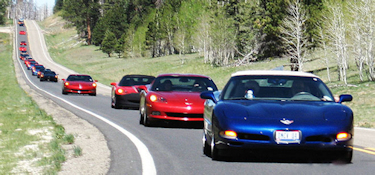Caravans 101 - A Refresher Course
A long string of Corvettes in a caravan is fun - unless you are near the end. Those poor drivers near the end are in a constant speed up - slow down mode. This is caused by a ripple effect.

The severity of the ripple is dependent on the lead car speed. A caravan in town is different, as there are many outside elements or factors that can cause a disruption in the flow. So, we'll look at a freeway or open highway scenario. First off, if at all possible, all Corvettes should be lined up on the shoulder. The lead and tail Corvette should be in contact when starting the caravan. Again, ideally the lead Corvette can see the tail Corvette - and when the tail Corvette finds a window of opportunity, they pull into the road, which signals the lead Corvette to start traveling. Depending on the number of Corvettes and the traffic situation, there is always the chance that the string will get broken for a few minutes. The lead Corvette should be traveling about 5 mph under the speed limit to begin with, and once the lead Corvette can see that all participants are assembled, or when the tail Corvette contacts the leader to advise that the string is intact - the lead can speed up.
A Corvette caravan needs to have each car spaced evenly, and at a safe distance from the Corvette ahead, but not so much room to where another car could get between Corvettes. The correct process is fairly simple. Once the caravan is together, the lead Corvette should set their cruise control at X mph. In short order, ideally, all Corvettes will have the appropriate distance behind the car in front and be able to set their cruise control to the speed limit.
The ripple effect begins with the first Corvette in line who slows down. Could be second in line, or ninth in line - slowing down is the start of the problems. This becomes a chain reaction. And when the Corvette that slowed down again speeds up to get back to the appropriate distance from the car in front - well - all Corvettes behind him take the same action. The closer you are to the tail, the worse the chain reaction is. On a freeway, with the lead traveling at 75 mph, it doesn't take much of a slowdown - let's say from the second Corvette in line - to cause everyone to back off, then speed up again. Traveling at 75 mph, it is not unthinkable for the cars near the tail to slow to 60 or less - only to speed up to 85 to catch-up as that 2nd Corvette gets back in position.
The severity of the ripple effect is directly related to how many Corvettes are on the caravan. But even with 5 or 6 Corvettes, the tail can still be affected. And having been at the tail many times, I personally know this speed-up slow-down become very annoying. And he recommendation is for the tail Corvette to travel with flashers on.
All of this seems pretty straight forward - but expect the line of Corvettes to get interrupted - someone needs to exit, and cuts in front of a car, or the leader comes up on a slower moving vehicle. Unless there are no other cars in the immediate left lane, the caravan is very likely to be splintered, but soon after all Corvettes have passed the slower vehicle, they should all fall back into a steady, constant speed. And on a highway the lead may encounter the speed limit going from 50 mph to 60 mph. If all Corvettes make that adjustment when the car in front of them begins to speed up, you will quickly regain the desired formation. Traveling on backroads where you encounter multiple small towns which require a slower speed then back up to speed in a short time should not be an issue if the above is followed.
Once again, I know I have been at fault by slowing down inadvertently while messing with the radio or some other distraction. And I have seen the lead Corvette jockey around with speed - and when the leader does this, everyone is in a state of different speeds trying to maintain the caravan as a unit. And as we all know, there is a satisfaction of "showing off" as this long line of shiny Corvettes rolls past by-standers who look, wave and wish it were them behind the wheel. A nice, evenly spaced, unbroken parade is the best possible show. Finally, if you are tired of being jostled around near or at the tail - then volunteer to be the lead!
Source: Phil Ellison - NMCA
Posted 10/23/20